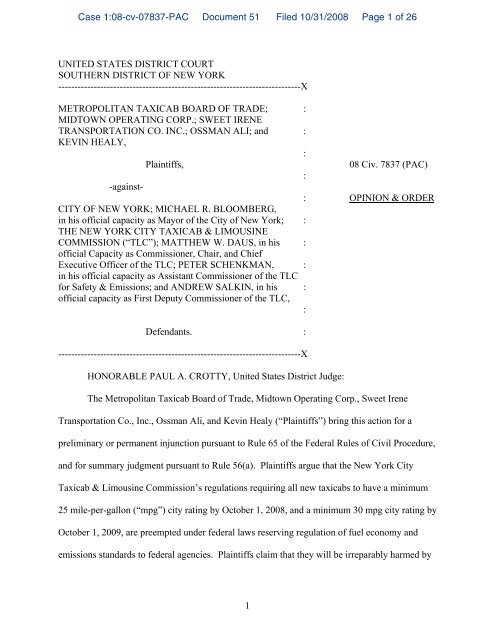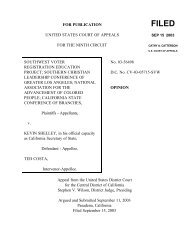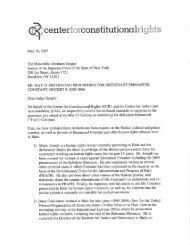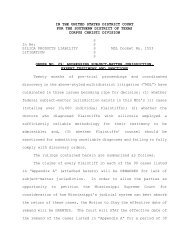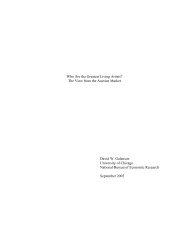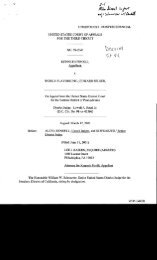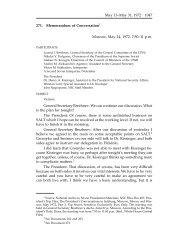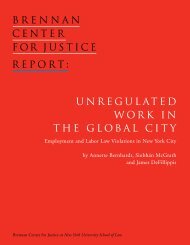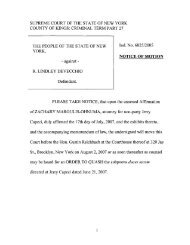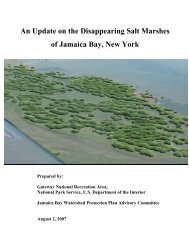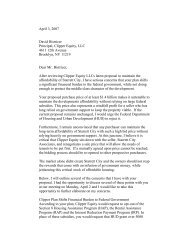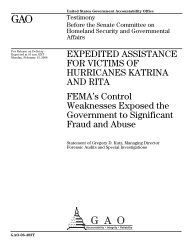UNITED STATES DISTRICT COURT SOUTHERN DISTRICT OF ...
UNITED STATES DISTRICT COURT SOUTHERN DISTRICT OF ...
UNITED STATES DISTRICT COURT SOUTHERN DISTRICT OF ...
You also want an ePaper? Increase the reach of your titles
YUMPU automatically turns print PDFs into web optimized ePapers that Google loves.
Case 1:08-cv-07837-PAC Document 51 Filed 10/31/2008 Page 1 of 26<br />
<strong>UNITED</strong> <strong>STATES</strong> <strong>DISTRICT</strong> <strong>COURT</strong><br />
<strong>SOUTHERN</strong> <strong>DISTRICT</strong> <strong>OF</strong> NEW YORK<br />
---------------------------------------------------------------------------X<br />
METROPOLITAN TAXICAB BOARD <strong>OF</strong> TRADE; :<br />
MIDTOWN OPERATING CORP.; SWEET IRENE<br />
TRANSPORTATION CO. INC.; OSSMAN ALI; and :<br />
KEVIN HEALY,<br />
:<br />
Plaintiffs, 08 Civ. 7837 (PAC)<br />
:<br />
-against-<br />
: OPINION & ORDER<br />
CITY <strong>OF</strong> NEW YORK; MICHAEL R. BLOOMBERG,<br />
in his official capacity as Mayor of the City of New York; :<br />
THE NEW YORK CITY TAXICAB & LIMOUSINE<br />
COMMISSION (“TLC”); MATTHEW W. DAUS, in his :<br />
official Capacity as Commissioner, Chair, and Chief<br />
Executive Officer of the TLC; PETER SCHENKMAN, :<br />
in his official capacity as Assistant Commissioner of the TLC<br />
for Safety & Emissions; and ANDREW SALKIN, in his :<br />
official capacity as First Deputy Commissioner of the TLC,<br />
:<br />
Defendants. :<br />
---------------------------------------------------------------------------X<br />
HONORABLE PAUL A. CROTTY, United States District Judge:<br />
The Metropolitan Taxicab Board of Trade, Midtown Operating Corp., Sweet Irene<br />
Transportation Co., Inc., Ossman Ali, and Kevin Healy (“Plaintiffs”) bring this action for a<br />
preliminary or permanent injunction pursuant to Rule 65 of the Federal Rules of Civil Procedure,<br />
and for summary judgment pursuant to Rule 56(a). Plaintiffs argue that the New York City<br />
Taxicab & Limousine Commission’s regulations requiring all new taxicabs to have a minimum<br />
25 mile-per-gallon (“mpg”) city rating by October 1, 2008, and a minimum 30 mpg city rating by<br />
October 1, 2009, are preempted under federal laws reserving regulation of fuel economy and<br />
emissions standards to federal agencies. Plaintiffs claim that they will be irreparably harmed by<br />
1
Case 1:08-cv-07837-PAC Document 51 Filed 10/31/2008 Page 2 of 26<br />
this regulation because compliance will cause substantial costs which they cannot recover. The<br />
Court finds that Plaintiffs have standing to bring this action; that they will be irreparably harmed;<br />
and that Plaintiffs have demonstrated a likelihood of success on the issue of preemption. The<br />
City’s counterarguments are unconvincing. Accordingly, Plaintiffs’ motion for a preliminary<br />
injunction is GRANTED. As for Plaintiffs’ motion for summary judgment, the Court will not<br />
rule on summary judgment at this time. As anticipated by the Court’s September 15, 2008<br />
Order, the defendants will have 30 days from the time of this decision to answer or otherwise<br />
move with respect to Plaintiffs’ complaint. 1<br />
I. The Parties<br />
BACKGROUND 2<br />
The Plaintiffs in this action represent a full spectrum of the taxicab industry, from owner,<br />
to driver, to end user. 3 Plaintiff Metropolitan Taxicab Board of Trade (“MTBOT”) is a 56-year-<br />
old trade association made up of yellow medallion taxi (“taxicab” or “taxi”) fleets in New York<br />
City. MTBOT is the largest taxi fleet association in the United States, with 27 member fleets<br />
and more than 3,500 taxis. Plaintiff Midtown Operating Corp. (“Midtown”) is a private yellow<br />
taxicab garage. Midtown leases taxis to more than 800 independent contractors on a double-<br />
shifted (24-hour) daily basis. Every car leased at Midtown is a Crown Victoria Long Wheel<br />
Base (“LWB”). Plaintiff Sweet Irene Transportation Co. Inc. is a private New York corporation<br />
1 This case has been fast-tracked since Plaintiffs filed the complaint on September 8, 2008. The Court held a<br />
conference with the parties on September 11, 2008, and the City agreed to adjourn the effective date of the<br />
regulations from October 1, 2008, to November 1, 2008. The Court set an expedited briefing schedule and held oral<br />
arguments on October 17, 2008. The September 15, 2008 Order did not contemplate Plaintiffs’ summary judgment<br />
motion. Consistent with the parties’ agreement and the Court order, the Defendants should be accorded a fair<br />
opportunity to answer Plaintiffs’ complaint and take whatever discovery is necessary before any further motion<br />
practice.<br />
2 The facts in this section are derived from Plaintiff’s complaint, the parties’ statements of fact submitted<br />
pursuant to Local Rule 56.1, and supporting affidavits and exhibits, unless otherwise specified.<br />
3 Notably, taxi manufacturers are not among the plaintiffs here. Apparently they do not object to the TLC’s<br />
regulations and, according to the City, they are eager to supply new vehicles that comply with the regulations. (See<br />
Declaration of Ramin Pejan (“Pejan Decl.”) Ex. 10.)<br />
2
Case 1:08-cv-07837-PAC Document 51 Filed 10/31/2008 Page 3 of 26<br />
that owns and leases taxis. Plaintiff Ossman Ali is a Bronx resident and a self-employed<br />
independent contractor who leases and drives taxis. Plaintiff Kevin Healy lives in Roslyn<br />
Heights, N.Y., and is a frequent taxi passenger.<br />
Defendants are: the City of New York; the New York City Taxicab & Limousine<br />
Commission (“TLC”), which is an administrative agency of New York City whose purpose is to<br />
regulate the taxi and limousine industry; Mayor Michael Bloomberg, in his official capacity;<br />
Matthew Daus, in his capacity as Commissioner, Chair, and Chief Executive Officer of the TLC;<br />
Peter Schenkman, in his capacity as the Assistant Commissioner for Safety & Emissions of the<br />
TLC; and Andrew Salkin, in his capacity as TLC First Deputy Commissioner.<br />
II. The TLC’s 25/30 MPG Rules<br />
The TLC was created in 1971 and is governed by §§ 2300 et seq. of the New York City<br />
Charter, as well as by local laws passed by the New York City Council. The TLC has nine<br />
Commissioners, all appointed by the Mayor, with the advice and consent of the City Council.<br />
N.Y. City Charter § 2301(a). The TLC regulates essentially all aspects of taxi operations and<br />
licensing. Beyond the stated function of developing and improving taxi and limousine service in<br />
New York City, § 2300 states that the “further purpose” of the commission is to “adopt and<br />
establish an overall public transportation policy governing taxi, coach, limousine, wheelchair<br />
accessible van services and commuter van services as it relates to the overall public<br />
transportation network of the city . . . .” Id. § 2300. Pursuant to the City’s Charter, the TLC’s<br />
jurisdiction and powers include the “regulation and supervision of the business and industry of<br />
transportation of persons by licensed vehicles for hire in the city . . . .” Id. § 2303(a). Under<br />
these regulatory and supervisory powers, the TLC may set “[r]equirements of standards of<br />
3
Case 1:08-cv-07837-PAC Document 51 Filed 10/31/2008 Page 4 of 26<br />
safety, and design, comfort, convenience, noise and air pollution control and efficiency in the<br />
operation of vehicles and auxiliary equipment.” Id. § 2303(b)(6).<br />
On December 11, 2007, following a public hearing, the TLC adopted new rules affecting<br />
the minimum mileage-per-gallon requirements that all new taxicabs in New York City must meet<br />
by October 1, 2008, and October 1, 2009. The new rules state that all new taxicabs must be<br />
either wheelchair accessible or must have: “[A] minimum city rating of twenty-five (25) miles<br />
per gallon as labeled pursuant to title 49, section 32908 of the United States Code and<br />
regulations promulgated pursuant thereto . . .” by October 1, 2008; and “[A] minimum city rating<br />
of thirty (30) miles per gallon as labeled pursuant to title 49, section 32908 of the United States<br />
Code and regulations promulgated pursuant thereto . . .” by October 1, 2009. TLC Rule §<br />
3.03(c)(10)-(11), 35 RCNY § 3-03(c)(10)-(11) (“25/30 Rules”). 4<br />
The rules were published for public comment in the City Record on October 22, 2007,<br />
comments were made, and notice of the promulgation of the new rules was published in the City<br />
Record on December 18, 2007. Record notice listed the benefits of the 25/30 Rules as industry-<br />
wide gasoline savings and the resulting easing of pressure to increase taxi fares for the public.<br />
On May 8, 2008, the TLC held another public hearing on the rules.<br />
While the 25/30 Rules do not state that the new taxis must have hybrid engines, the effect<br />
of the minimum mpg standard is that only cars with hybrid engines or clean diesel engines can<br />
meet the mileage standard requirement. Taxis have a mandatory retirement of three to five<br />
years, 5 so, as a result of the new rule, essentially all taxis in the City would be hybrids by 2012.<br />
4<br />
49 U.S.C. § 32908 sets forth federal requirements for the labeling of fuel economy information on vehicles.<br />
See § 32908(b).<br />
5<br />
If a taxi is double shifted and not driven by a long-term driver it must be retired after three years. If a taxi<br />
is not double shifted or is driven by a long-term driver it must be retired after five years. A taxi can receive a oneor<br />
two-year extension if it is a “clean air” taxi or operates using compressed natural gas. See TLC Rule § 3-02.<br />
4
Case 1:08-cv-07837-PAC Document 51 Filed 10/31/2008 Page 5 of 26<br />
By the end of November 2007, of the city’s 13,000 taxis, approximately 700 were hybrids. 6<br />
More than 90% of all taxis were Crown Victoria non-hybrid vehicles, which do not meet the<br />
mpg requirement under the TLC’s 25/30 Rules.<br />
III. Hybrid History Among New York City Taxis<br />
New York City contemplated incorporating hybrid vehicles into the City’s taxi fleet in<br />
2003. That year the City enacted a local law permitting the TLC to issue additional taxi licenses,<br />
provided that at least 9% of the licenses went to cars powered by compressed natural gas or<br />
hybrids. See N.Y. City Admin. Code § 19-532(b). Over the next two years the TLC conducted<br />
bids for alternative-fuel vehicle licenses, but failed to approve any vehicles for use as taxis<br />
because, according to the Plaintiffs, the vehicles did not meet the TLC requirements for interior<br />
room. (See Declaration of Elizabeth Saylor (“Saylor Decl.”) Ex. A ¶¶ 46-51.) In 2005 the TLC<br />
adopted new specifications on interior volume, headroom, legroom, and other categories, which,<br />
according to Plaintiffs, allowed hybrid vehicles to meet TLC guidelines. (Id. ¶ 52.) Starting in<br />
October 2005, the TLC began approving hybrid cars for use as taxis. The TLC currently<br />
approves 10 types of hybrid and clean diesel vehicles for taxi use.<br />
On April 22, 2007, Mayor Bloomberg announced a broad environmental proposal called<br />
“PlaNYC 2030” that included “doubl[ing] the efficiency of new taxis by 2012,” which “could<br />
result in the entire fleet being converted to more fuel-efficient vehicles within eight to 10 years.”<br />
(Id. Ex. F.) One month later, on May 22, 2007, Mayor Bloomberg announced that the City<br />
planned to make the taxicab fleet fully hybrid by 2012. (Id. Ex E.) The phase-in plan for hybrid<br />
taxis includes: 1,000 hybrids by October 2008; 4,000 hybrids by October 2009; 7,000 by<br />
October 2010; 10,000 by October 2011; and a fully hybrid fleet by October 2012. (Id.) The TLC<br />
subsequently passed the 25/30 Rules.<br />
6 By mid-August 2008, the number of hybrid taxis was more than 1,000.<br />
5
Case 1:08-cv-07837-PAC Document 51 Filed 10/31/2008 Page 6 of 26<br />
IV. Plaintiffs’ Claims and Procedural History<br />
Plaintiffs filed their complaint on September 8, 2008. Plaintiffs claim that the 25/30<br />
Rules are expressly and impliedly preempted by two federal regulations: the Energy Policy and<br />
Conservation Act of 1975 (“EPCA”), 49 U.S.C. §§ 32901 et seq., and the Federal Clean Air Act<br />
(“CAA”), 42 U.S.C. §§ 7401 et seq. Plaintiffs requested a preliminary or permanent injunction<br />
preventing the City from implementing the 25/30 Rules on October 1 or, alternatively, summary<br />
judgment on their preemption claim. 7 As indicated in footnote 1, the Defendants agreed to delay<br />
implementation of the 25/30 Rules until November 1, 2008, so that the parties and the Court<br />
would have sufficient time to brief and consider the matter. (See September 15, 2008 Order<br />
(“Sept. 15 Order”) 3 ¶ 1.)<br />
I. Preliminary Injunction Standard<br />
DISCUSSION<br />
To obtain a preliminary injunction, the moving party must show that it is likely to suffer<br />
irreparable harm without the requested relief, as well as either: (1) a likelihood of success on the<br />
merits; or (2) “sufficiently serious questions going to the merits to make them a fair ground for<br />
litigation and a balance of hardships tipping decidedly toward the party requesting the<br />
preliminary relief.” Citibank, N.A. v. Citytrust, 756 F. 2d 273, 275 (2d Cir. 1985) (citing<br />
Mamiya Co. v. Masel Supply Co. Corp., 719 F.2d 42, 45 (2d Cir. 1983)). Where a party seeks to<br />
enjoin government action “taken in the public interest pursuant to a statutory or regulatory<br />
scheme, however, the moving party cannot resort to the ‘fair ground for litigation’ standard, but<br />
is required to demonstrate irreparable harm and a likelihood of success on the merits.” Jolly v.<br />
Coughlin, 76 F.3d 468, 473 (2d Cir. 1996) (internal quotations omitted). Since the TLC is a<br />
7 Plaintiffs’ complaint also alleges that the TLC 25/30 Rules violate N.Y. C.P.L.R. Article 78, but Plaintiffs<br />
have not moved for relief on this claim. Accordingly, the Court does not consider the issue.<br />
6
Case 1:08-cv-07837-PAC Document 51 Filed 10/31/2008 Page 7 of 26<br />
government agency acting in the public interest, Plaintiffs must show a likelihood of success on<br />
the merits.<br />
Irreparable harm “means injury for which a monetary award cannot be adequate<br />
compensation.” Jayaraj v. Scappini, 66 F.3d 36, 39 (2d Cir. 1995) (quoting Jackson Dairy, Inc. v.<br />
H.P. Hood & Sons, Inc., 596 F.2d 70, 72 (2d Cir. 1979)). Additionally, the “[i]rreparable harm<br />
must be shown by the moving party to be imminent, not remote or speculative.” Reuters, Ltd. v.<br />
United Press Int’l, Inc., 903 F.2d 904, 907 (2d Cir. 1990).<br />
Plaintiffs argue that they satisfy the preliminary injunction standards: (1) they will suffer<br />
irreparable harm because they will incur financial damage under the 25/30 Rules and will be<br />
unable to recoup those damages through a claim under 42 U.S.C. § 1983; and (2) they are likely<br />
to succeed on the merits because the 25/30 Rules are preempted by federal law, and the City does<br />
not fall within the scope of the applicable exemptions. The Court first examines Plaintiffs’<br />
standing to bring a claim under the Supremacy Clause, and then discusses Plaintiffs’ claims on<br />
irreparable harm and likelihood of success on the merits.<br />
II. Plaintiffs’ Standing to Sue<br />
While Defendants suggest 8 that Plaintiffs lack standing (see Oct. 17, 2008 Oral Argument<br />
Tr. (“Oral Arg. Tr.”) 18:19-19:05; Defendants’ Memorandum in Opposition (“Def. Mem.”) 13<br />
n.10), Plaintiffs clearly have standing.<br />
The Supremacy Clause, U.S. Const. art. VI, cl. 2, provides a plaintiff with a cause of<br />
action to seek injunctive relief from allegedly preempted state action. See Shaw v. Delta Air<br />
Lines, 463 U.S. 85, 96 n.14 (1983) (“A plaintiff who seeks injunctive relief from state regulation,<br />
on the ground that such regulation is pre-empted by a federal statute which, by virtue of the<br />
8 This issue has not been fully briefed by the parties but was addressed in a footnote in Defendants’ response<br />
brief and by Defendants at oral argument.<br />
7
Case 1:08-cv-07837-PAC Document 51 Filed 10/31/2008 Page 8 of 26<br />
Supremacy Clause of the Constitution, must prevail, thus presents a federal question which the<br />
federal courts have jurisdiction under 28 U.S.C. § 1331 to resolve.”); see also Indep. Living Ctr.<br />
of S. Cal., Inc. v. Shewry, No. 08-56061, 2008 WL 4224917, at *13 (9th Cir. Sept. 17, 2008)<br />
(“[N]one of the Court’s seminal preemption cases casts any doubt on the presumptive<br />
availability of declaratory and injunctive relief under the Supremacy Clause; to the contrary, the<br />
Court has consistently assumed—without comment—that the Supremacy Clause provides a<br />
cause of action to enjoin implementation of allegedly unlawful state legislation.”).<br />
Defendants suggest that Plaintiffs do not satisfy Article III standing requirements because<br />
Plaintiffs have not suffered an invasion of a legally protected interest. Under Lujan v. Defenders<br />
of Wildlife, 504 U.S. 555 (1992), the constitutional standing requirement has three elements:<br />
First, the plaintiff must have suffered an injury in fact—an invasion of a<br />
legally protected interest which is (a) concrete and particularized, and (b)<br />
actual or imminent, not conjectural or hypothetical. Second, there must be a<br />
causal connection between the injury and the conduct complained of—the<br />
injury has to be fairly traceable to the challenged action of the defendant, and<br />
not the result of the independent action of some third party not before the<br />
court. Third, it must be likely, as opposed to merely speculative, that the<br />
injury will be redressed by a favorable decision.<br />
Id. at 560-61 (internal citations, quotation marks, and alterations omitted). Defendants argue that<br />
any legally protected interest under the EPCA and the CAA belongs exclusively to the<br />
automobile manufacturers, not at all to the Plaintiffs. But it would cause considerable mischief<br />
to recognize the City’s argument that the absence of an objection by the auto manufacturers<br />
enables it to do whatever it wishes, regardless of the language of the EPCA and the CAA. Lujan<br />
itself points out that where a suit challenges the legality of government action, a plaintiff’s ability<br />
to establish standing “depends considerably upon whether the plaintiff is himself an object of the<br />
action (or forgone action) at issue. If he is, there is ordinarily little question that the action or<br />
inaction has caused him injury, and that a judgment preventing or requiring the action will<br />
8
Case 1:08-cv-07837-PAC Document 51 Filed 10/31/2008 Page 9 of 26<br />
redress it.” Id. at 561-62. Here, Plaintiffs, not auto manufacturers, are the subject of the 25/30<br />
Rules, and they are the ones who will suffer injury by the imposition of the City’s regulations.<br />
The Court finds that Plaintiffs have standing to bring this action.<br />
III. Irreparable Harm and the Likelihood of Recovery Under § 1983<br />
Plaintiffs claim that they will suffer irreparable harm because they will incur financial<br />
damages under the 25/30 Rules. 9 Plaintiffs contend that the available hybrid vehicles are more<br />
expensive to purchase, maintain, and repair, as compared to the Crown Victoria LWB. (See, e.g.,<br />
Saylor Decl. Ex. A ¶¶ 120-29; Reply Declaration of Elizabeth Saylor (“Saylor Reply”) Ex. EE,<br />
Ex. HH, Ex. MM; Reply Declaration of Ronald Sherman (“Sherman Reply”) ¶ 9.) These<br />
transactional costs are identifiable and readily calculable. Normally they would not be<br />
considered irreparable, if they were recoverable. Plaintiffs argue, however, that they have no<br />
private right of action and cannot recover their damages under 42 U.S.C. § 1983.<br />
Section 1983 does not create a private right of action. It provides a mechanism for<br />
recovery where the Constitution or relevant statute gives a citizen a right to an action. See<br />
Golden State Transit Corp. v. Los Angeles, 493 U.S. 103, 108 (“In all cases, the availability of<br />
the § 1983 remedy turns on whether the statute . . . creates obligations sufficiently specific and<br />
definite to be within the competence of the judiciary to enforce, is intended to benefit the<br />
putative plaintiff, and is not foreclosed by express provision or other specific evidence from the<br />
statute itself.”) (internal citations and quotations omitted). Thus, a plaintiff with standing to sue<br />
for federal preemption under the Supremacy Clause does not necessarily also have a claim for<br />
damages under § 1983. See e.g., Loyal Tire & Auto Ctr., Inc. v. Town of Woodbury, 445 F.3d<br />
136, 149 (2d Cir. 2006); Wachovia Bank, N.A., v. Burke, 414 F.3d 305, 321 (2d Cir. 2005). A<br />
9 Plaintiffs also claim that they will suffer irreparable physical damages from the 25/30 Rules because the<br />
TLC-approved hybrid taxis are untested and unsafe. The Court does not rule on that claim at this time.<br />
9
Case 1:08-cv-07837-PAC Document 51 Filed 10/31/2008 Page 10 of 26<br />
plaintiff only has a damages claim under § 1983 when a federal statute creates rights enforceable<br />
by § 1983. Gonzaga Univ. v. Doe, 536 U.S. 273, 283-84 (2002) (“[A] plaintiff suing under an<br />
implied right of action still must show that the statute manifests an intent to create not just a<br />
private right but also a private remedy.”) (citation and internal quotations omitted) (emphasis in<br />
original); De Los Santos Mora v. New York, 524 F.3d 183, 195 (2d Cir. 2008) (citing Gonzaga,<br />
536 U.S. at 289 n.7). Accordingly, “where the text and structure of a statute provide no<br />
indication that Congress intends to create new individual rights, there is no basis for a private<br />
suit” under § 1983. Gonzaga, 536 U.S. at 286.<br />
The Court in Loyal Tire & Auto Center, Inc. v. Town of Woodbury explained the<br />
distinction between a private claim under the Supremacy Clause and a private remedy under §<br />
1983: while a tow truck operator could sue the town alleging that a local law was preempted by a<br />
federal transportation law, the operator could not bring § 1983 claims because the federal statute<br />
did not “expressly grant any rights to individual motor carriers.” 445 F.3d 136, 150 (2d Cir.<br />
2006). A claim under § 1983 is distinct from a claim under the Supremacy Clause because a<br />
Supremacy Clause claim “simply asserts that a federal statute has taken away local authority to<br />
regulate a certain activity.” Id. at 149 (citing Western Air Lines, Inc. v. Port Auth. of N.Y. &<br />
N.J., 817 F.2d 222, 225 (2d Cir. 1987)).<br />
Whether the relevant statute creates a right depends first on Congress’ intent that the<br />
provision benefit the plaintiff. Id. Second, the plaintiff “must demonstrate that the right<br />
assertedly protected by the statute is not so vague and amorphous that its enforcement would<br />
strain judicial competence.” Id. at 150 (citing Wachovia, 414 F.3d at 321-22). Finally, the<br />
statute must clearly impose a binding obligation on the states. Id.<br />
10
Case 1:08-cv-07837-PAC Document 51 Filed 10/31/2008 Page 11 of 26<br />
Applying those factors here, there is no indication that Congress intended the EPCA to<br />
benefit the individual vehicle owner or user. The focus of the EPCA is on regulating fuel<br />
economy standards across an entire fleet of manufacturer vehicle models. See 49 U.S.C. §<br />
32901(a)(6); see also infra Part IV(A). Nothing in the EPCA expressly grants rights to<br />
individual drivers or owners. The statute focuses on the regulated parties and does not put an<br />
emphasis on the individual. Thus, it is likely that a court would not permit Plaintiffs to recover<br />
their expected damages through a § 1983 claim.<br />
Additionally, Defendants rejected the Plaintiffs’ offer to withdraw the motion for an<br />
injunction if Defendants would stipulate to Plaintiffs’ right to damages if the 25/30 Rules are<br />
implemented and then struck down. (See Defendants’ Letter of October 17, 2008 (“Def. Oct. 17<br />
Letter”).) This suggests that the Defendants themselves do not believe that Plaintiffs have a<br />
viable damages claim.<br />
Finally, Defendants argue that Plaintiffs cannot show irreparable harm because Plaintiffs<br />
delayed until the final moment to seek injunctive relief, even though Plaintiffs knew about the<br />
impending TLC regulations for months. Defendants argue that Plaintiffs created their own harm<br />
through their delay. While a plaintiff’s failure to act promptly in seeking injunctive relief can<br />
“undercut[]” the sense of urgency and suggest that there is no irreparable injury, see Citibank,<br />
756 F.2d at 277, that is not the proper analysis here. Citibank, N.A. v. Citytrust dealt with a<br />
trademark claim, where the harm was immediately apparent upon infringement of the trademark,<br />
so there was no excuse for the filing delay. Id. at 276-77. Courts will excuse a delay, however,<br />
where “the harm largely is prospective and will arise from a discrete future event.” Million<br />
Youth March, Inc. v. Safir, 18 F. Supp. 2d 334, 340 (S.D.N.Y. 1998). Here, the harm to the<br />
Plaintiffs is in the future, and the exact amount and timing of the harm is not clear. In these<br />
11
Case 1:08-cv-07837-PAC Document 51 Filed 10/31/2008 Page 12 of 26<br />
circumstances, Plaintiffs’ delay in bringing this action for injunction does not suggest a lack of<br />
urgency or bar them from relief.<br />
Plaintiffs have shown that they are likely to suffer irreparable harm from enforcement of<br />
the 25/30 Rules because they will incur costs to comply with the regulations which they cannot<br />
recover in an action pursuant to 42 U.S.C. § 1983. The Court now turns to whether Plaintiffs<br />
have shown a likelihood of success on the merits.<br />
IV. Likelihood of Success on the Merits<br />
Plaintiffs argue that they are likely to succeed on the merits because the 25/30 Rules are<br />
preempted by federal law. Before conducting a preemption analysis, the Court notes that it does<br />
not consider the question of whether hybrid vehicles are safe for operation as taxicabs. It does<br />
not consider the affidavits or reports from Plaintiffs’ engineer C. Bruce Gambardella or<br />
Defendants’ rebuttal report from Ricardo Inc. (See Saylor Decl. Ex. B; Declaration of Ramin<br />
Pejan (“Pejan Decl.”) Ex. 1.) Those matters are better suited to the Article 78 claim, which, as<br />
previously indicated, the Court does not consider. While Plaintiffs seem to place emphasis on<br />
the TLC’s motivation for its actions up to and including the adoption of the fuel economy<br />
standards in December 2007, the Court does not rely upon or give any weight to those<br />
arguments. Instead, the Court focuses on the words of the TLC’s regulation and analyzes<br />
whether the regulation, as written, is preempted by federal law.<br />
The Supremacy Clause, U.S. Const. art. VI, cl. 2, “invalidates state laws that interfere<br />
with, or are contrary to, federal law.” Hillsborough County, Fla. v. Automated Med. Labs., Inc.,<br />
471 U.S. 707, 712 (1985) (internal quotation omitted). “State action may be foreclosed by<br />
express language in a congressional enactment, by implication from the depth and breadth of a<br />
congressional scheme that occupies the legislative field, or by implication because of a conflict<br />
12
Case 1:08-cv-07837-PAC Document 51 Filed 10/31/2008 Page 13 of 26<br />
with a congressional enactment.” Lorillard Tobacco Co. v. Reilly, 533 U.S. 525, 541 (2001)<br />
(internal citations omitted). Conflict preemption exists either when “compliance with both<br />
federal and state regulations is a physical impossibility,” Florida Lime & Avocado Growers, Inc.<br />
v. Paul, 373 U.S. 132, 142-43 (1963), or where state law “stands as an obstacle to the<br />
accomplishment and execution of the full purposes and objectives of Congress.” Hines v.<br />
Davidowitz, 312 U.S. 52, 67 (1941). There is a general presumption against preemption; thus, “a<br />
state’s police powers are not displaced by federal law unless there is compelling evidence that<br />
this was the manifest aim of Congress.” Environmental Encapsulating Corp. v. City of New<br />
York, 855 F.2d 48, 58 (2d Cir. 1988). In every preemption case, “the purpose of Congress is the<br />
ultimate touch-stone” in determining the scope of a preemption statute. Medtronic, Inc. v. Lohr,<br />
518 U.S. 470, 485-86 (1996).<br />
Actions taken by a state or political subdivision may not be preempted in some<br />
circumstances where the state acts as a market participant, rather than as a market regulator. See<br />
Bldg. & Constr. Trades Council v. Associated Builders and Contractors, Inc., 507 U.S. 210, 227<br />
(1993) (“Boston Harbor”) (“Our decisions in this area support the distinction between<br />
government as regulator and government as proprietor.”) The Court in Boston Harbor described<br />
the distinction between when the state acts as a regulator and when the state acts as a participant.<br />
Id. at 229 (“When the State acts as a regulator, it performs a role that is characteristically a<br />
governmental rather than a private role . . . These distinctions are far less significant when the<br />
State acts as a market participant with no interest in setting policy.”). The market participant<br />
doctrine is an extension of a principle from the Commerce Clause, under which a state may favor<br />
its own citizens over others when the state is an active participant in the relevant market. See<br />
e.g., Hughes v. Alexandria Scrap Corp., 426 U.S. 794, 810 (1976). The market participant<br />
13
Case 1:08-cv-07837-PAC Document 51 Filed 10/31/2008 Page 14 of 26<br />
doctrine has been extended to preemption jurisprudence most commonly in federal labor law<br />
actions, see, e.g., Chamber of Commerce of the United States v. Brown, 128 S. Ct. 2408, 2415<br />
(2008); Boston Harbor, 507 U.S. at 227; Healthcare Ass’n of New York State v. Pataki, 471 F.3d<br />
87, 108-09 (2d Cir. 2006), but also in environmental regulation cases. See, e.g., Engine Mfrs.<br />
Ass’n v. S. Coast Air Quality Mgmt. Dist., 498 F.3d 1031, 1042 (9th Cir. 2007). A threshold<br />
question when applying the market participant doctrine is whether the regulation in question<br />
contains “‘any express or implied indication by Congress’ that the presumption embodied by the<br />
market participant doctrine should not apply to preemption under the [regulation in question].”<br />
Id. (quoting Boston Harbor, 507 U.S. at 231).<br />
A. Preemption Under the EPCA<br />
The goals of the EPCA are to improve motor vehicle efficiency and to “decrease<br />
dependence on foreign [oil] imports, enhance national security, achieve the efficient utilization<br />
of scarce resources, and guarantee the availability of domestic energy supplies at prices<br />
consumers can afford.” Ctr. for Biological Diversity v. Nat’l Highway Traffic Safety Admin.,<br />
538 F.3d 1172, 1182 (9th Cir. 2008) (quoting S. Rep. No. 94-516 (1975) (Conf. Rep.), as<br />
reprinted in 1975 U.S.C.C.A.N. 1956, 1957); Green Mountain Chrysler Plymouth Dodge Jeep v.<br />
Crombie, 508 F. Supp. 2d 295, 306 (D. Vt. 2007). Under the EPCA, the Department of<br />
Transportation (“DOT”) is charged with establishing federal fuel economy standards on a fleet-<br />
wide basis. See 49 U.S.C. §§ 32902(a), 32902(c). These average standards are known as<br />
“corporate average fuel economy” or “CAFE” standards. The CAFE standard is “a performance<br />
standard specifying a minimum level of average fuel economy applicable to a manufacturer in a<br />
model year.” Id. § 32901(a)(6).<br />
14
The DOT has delegated the responsibility for setting fuel economy standards to the<br />
National Highway Traffic Safety Administration (“NHTSA”). 49 C.F.R. § 1.50(f). The NHTSA<br />
must weigh four factors when setting standards: “technological feasibility, economic<br />
practicability, the effect of other motor vehicle standards of the Government on fuel economy,<br />
and the need of the United States to conserve energy.” 49 U.S.C. § 32902(f). The NHTSA has<br />
interpreted “economic practicability” to include consideration of consumer choice, economic<br />
hardship for the auto industry, and vehicle safety. Green Mountain, 508 F. Supp. 2d at 307.<br />
The EPCA also contains an express preemption clause:<br />
When an average fuel economy standard prescribed under this chapter . . .<br />
is in effect, a State or political subdivision of a State may not adopt or<br />
enforce a law or regulation related to fuel economy standards or average<br />
fuel economy standards for automobiles covered by an average fuel<br />
economy standard under this chapter.<br />
49 U.S.C. § 32919(a). This language is quite clear in its direction: “Congress’s undoubted intent<br />
was to make the setting of fuel economy standards exclusively a federal concern.” Green<br />
Mountain, 508 F. Supp. 2d at 354. The preemption provision also contains an exemption, or a<br />
savings clause: “A State or a political subdivision of a State may prescribe requirements for fuel<br />
economy for automobiles obtained for its own use.” 49 U.S.C. § 32919(c).<br />
Plaintiffs argue that the TLC’s 25/30 Rules are preempted by the express language of §<br />
32919(a) and also impliedly preempted because the rules interfere with the federal fuel economy<br />
program, thwarting Congress’ intent that regulation of fuel economy standards occur at the<br />
national level. They also argue that the City is not exempted from preemption by the savings<br />
clause at § 32919(c) because taxicabs in New York City are not vehicles for the City’s “own<br />
use.”<br />
Case 1:08-cv-07837-PAC Document 51 Filed 10/31/2008 Page 15 of 26<br />
15
Case 1:08-cv-07837-PAC Document 51 Filed 10/31/2008 Page 16 of 26<br />
To determine whether the 25/30 Rules are expressly preempted by § 32919(a) of the<br />
EPCA, the Court starts with the language of the statute. “Statutory construction must begin with<br />
the language employed by Congress and the assumption that the ordinary meaning of that<br />
language accurately expresses the legislative purpose.” Park ’N Fly, Inc. v. Dollar Park & Fly,<br />
Inc., 469 U.S. 189, 194 (1985). The relevant question when looking at § 32919(a) is whether the<br />
25/30 Rules are “related to fuel economy standards.” If so, the rules are expressly preempted<br />
unless the savings clause or another exception applies.<br />
The EPCA defines “fuel economy” as “the average number of miles traveled by an<br />
automobile for each gallon of gasoline (or equivalent amount of other fuel) used . . . .” 49 U.S.C.<br />
§ 32901(a)(11). The Supreme Court has defined the term “standards” in the context of CAA<br />
preemption as “that which ‘is established by authority, custom, or general consent, as a model or<br />
example; criterion; test.’” Engine Manufacturers Association v. South Coast Air Quality<br />
Management District, 541 U.S. 246, 252-53 (2004) (quoting Webster’s Second New<br />
International Dictionary 2455 (1945)). A fair reading of the 25/30 Rules leads to but one<br />
conclusion: the rules set standards that relate to an average number of miles that New York City<br />
taxicabs must travel per gallon of gasoline.<br />
Any doubt about this conclusion is eliminated by the TLC regulations’ express<br />
incorporation of fuel economy standards as defined in the EPCA. The 25/30 Rules require “a<br />
minimum city rating of twenty-five (25) miles per gallon as labeled pursuant to title 49, section<br />
32908 of the United States Code . . .” by October 1, 2008, and “a minimum city rating of thirty<br />
(30) miles per gallon as labeled pursuant to title 49, section 32908 of the United States Code . . .”<br />
by October 1, 2009. TLC Rule § 3-02(c)(10)(i), (c)(11)(i) (emphasis added). The TLC’s<br />
regulations set fuel economy standards for taxicabs; and they are “related to fuel economy<br />
16
Case 1:08-cv-07837-PAC Document 51 Filed 10/31/2008 Page 17 of 26<br />
standards or average fuel economy standards” as contemplated under the EPCA’s preemption<br />
provision.<br />
The Supreme Court’s decision in Engine Manufacturers Association v. South Coast Air<br />
Quality Management District, 541 U.S. 246 (2004), also forecloses any argument that the EPCA<br />
applies only to fuel economy standards as they relate to manufacturers or sellers. In that case,<br />
which involved preemption under the CAA, not the EPCA, the Supreme Court clarified that<br />
CAA preemption applies equally to local emission laws addressed to purchasers of vehicles, as<br />
opposed to only manufacturers, sellers, or dealers. South Coast Air Quality Management District<br />
(“South Coast”) was a political subdivision of California responsible for air pollution control in<br />
the Los Angeles metropolitan area. South Coast adopted rules prohibiting various public and<br />
private fleet operators from purchasing or leasing vehicles not in compliance with stringent<br />
emission requirements. Id. at 248-49 (rules governed operators of fleets of street sweepers,<br />
passenger cars, public transit vehicles, including shuttles and taxicabs picking up airline<br />
passengers, as well as other fleet operators). The Court, in an 8-1 decision, held that a state law<br />
that restricted emissions in new vehicles was preempted whether it targeted purchasers or<br />
manufacturers. Id. at 253-55 (finding that the district court’s interpretation of the word<br />
“standard” in the CAA’s preemption language was flawed). Additionally, the Court held that it<br />
made “no sense” to treat sales restrictions and purchase restrictions differently for preemption<br />
reasons. Id. at 255 (“The manufacturer’s right to sell federally approved vehicles is meaningless<br />
in the absence of a purchaser’s right to buy them.”). For the same reasons stated in Engine<br />
Manufacturers, EPCA preemption applies equally to state and local fuel economy laws<br />
addressing the purchase of vehicles.<br />
17
Case 1:08-cv-07837-PAC Document 51 Filed 10/31/2008 Page 18 of 26<br />
Defendants make several arguments against preemption. First, they urge that the 25/30<br />
Rules do not “relate to” fuel economy standards because the 25/30 Rules do not interfere with<br />
the objectives of the EPCA. To support this argument Defendants quote a passage from a<br />
NHTSA rulemaking report, which states: “EPCA’s express preemption provision cannot be<br />
interpreted as preempting all State laws relating to a fuel economy standard, no matter how<br />
tangential the relationship.” See Average Fuel Economy Standards for Light Trucks Model<br />
Years 2008-2011, 71 Fed. Reg. 17566, 17670 (April 6, 2006). This quote is taken out of context.<br />
When the entire passage is read it becomes clear that the statement summarizes NHTSA’s view<br />
that not all emissions standards should be preempted under the EPCA, a position endorsed by<br />
this Court. See infra Part IV(B)(2).<br />
Defendants also argue that federal jurisprudence is moving toward an interpretation of the<br />
term “related to” in preemption cases as meaning “actually interfering” with the relevant federal<br />
regulation. See Abdu-Brisson v. Delta Airlines, Inc., 128 F.3d 77, 82 (2d Cir. 1997) (“‘Related<br />
to’ appears to be developing, to some degree, to mean whether state law actually ‘interferes’ with<br />
the purposes of the federal statute.”). Thus, Defendants urge, because the 25/30 Rules do not<br />
actually interfere with the purpose of the EPCA, the rules should not be preempted. This<br />
argument, however, is no longer tenable in light of the Supreme Court’s decision in Engine<br />
Manufacturers. The Court found that even though the emissions regulations at issue had a<br />
limited impact on the goals of the CAA, allowing one state to enact such a rule could have an<br />
unwanted aggregate effect if many states followed suit. See Engine Mfrs., 541 U.S. at 255 (“[I]f<br />
one State or political subdivision may enact such rules, then so may any other; and the end result<br />
would undo Congress’s carefully calibrated regulatory scheme.”). The teaching of Engine<br />
18
Case 1:08-cv-07837-PAC Document 51 Filed 10/31/2008 Page 19 of 26<br />
Manufacturers requires the rejection of Defendants’ argument that “related to” means “actually<br />
affecting” or “interfering.”<br />
Second, Defendants claim that the 25/30 Rules are exempted by the “own use” savings<br />
clause in § 32919(c) of the EPCA. Defendants argue that taxis are uniquely part of New York<br />
City’s public transportation system, and that the language of § 2300 of the New York Charter<br />
reflects the TLC’s role in regulating taxis as part of the City’s public transportation network.<br />
Defendants also claim that the City’s regulation of the taxicab industry through its licensing<br />
system transforms the City into a participant of the taxicab industry, and thus they are protected<br />
by the market participant doctrine. This argument tortures both language and logic.<br />
Defendants might be exempted from preemption if they could show that the City was a<br />
participant in the taxicab industry and that the imposition of the 25/30 Rules was not the act of a<br />
market regulator. In Boston Harbor, the Court found that the market participant exception could<br />
apply when a state act was more akin to proprietary conduct than to government regulation. 507<br />
U.S. at 232. Likewise, the Court in Engine Manufacturers noted that its CAA preemption<br />
decision did not reach the question of whether some of the fleet restrictions were valid as internal<br />
state purchase decisions. 541 U.S. at 258-59. On remand, the Ninth Circuit held that the market<br />
participant doctrine allowed state and local government entities “to use their own money to<br />
acquire or use vehicles that exceed the federal standards.” Engine Mfrs., 498 F.3d 1031, 1043<br />
(9th Cir. 2007). The Ninth Circuit found that the fleet restrictions, limited to the purchase and<br />
use of vehicles by the state and local government entities, were proprietary actions, rather than<br />
regulatory actions. Id. at 1045-46. Accordingly, the state could impose restrictions on vehicles<br />
procured by state municipalities under the market participant doctrine.<br />
19
Case 1:08-cv-07837-PAC Document 51 Filed 10/31/2008 Page 20 of 26<br />
The TLC’s 25/30 Rules are not analogous to the fleet restrictions that the Ninth Circuit<br />
permitted under the market participant doctrine. The TLC’s rules apply to all privately owned,<br />
licensed yellow taxicabs in New York City, while the fleet restrictions that the Ninth Circuit<br />
allowed in Engine Manufacturers applied only to vehicles procured by state and local<br />
governmental entities for their own use. 498 F.3d at 1039.<br />
The City’s argument that the nature of the TLC’s medallion system makes the City a<br />
market participant is fanciful. At oral argument, Defendants claimed that the medallion<br />
regulation system gives the City ownership and control of the industry, and that this role as<br />
gatekeeper into the taxicab business somehow makes the TLC a market participant. (See Oral<br />
Arg. Tr. 33:07-13; 33:21-34:02.) Defendants also argued that the “own use” exception of §<br />
32919(c) applies because the 25/30 Rules relate to improving the City’s public transportation<br />
system through efficient procurement of taxis, outsourced to private companies. (Id. 28:11-16;<br />
33:07-13.) The Defendants’ position on their role as taxicab industry participant, rather than<br />
regulator, is not supported by the City Charter, by case law, or by common sense.<br />
As written, the 25/30 Rules present taxi owners with an alternative: provide a service to<br />
the handicapped or buy a vehicle with improved fuel economy. See TLC Rule § 3.03(c)(10)-<br />
(11). This is the kind of mandate that only a regulator makes—it is not typical of what a<br />
proprietor would do for itself, and it would be a strange choice to impose for one’s own use.<br />
Furthermore, the process the City followed in promulgating the 25/30 Rules belies any claim that<br />
the City is acting as a proprietor rather than a regulator. The City published notice of its intent to<br />
adopt new TLC rules in the City Record, took public comments, and then adopted the new rules.<br />
It even held additional public hearings. (See Pejan Decl. Ex. 21; Ex. 22; Ex. 23; Ex. 25; Ex. 28.)<br />
This is not the kind of conduct the City engages in when it purchases vehicles for its own use.<br />
20
Case 1:08-cv-07837-PAC Document 51 Filed 10/31/2008 Page 21 of 26<br />
Internal administrative actions do not require notice, public comment, or hearings. The<br />
procedures the City followed are the actions of a regulator, not of a proprietor. The City Charter,<br />
which is the source of the TLC’s power to act, specifies: “The jurisdiction, powers and duties of<br />
the commission shall include the regulation and supervision of [the taxicab industry].” See N.Y.<br />
City Charter § 2303(a) (emphasis added). The TLC is clearly a regulator which routinely<br />
prescribes what the City’s taxicabs may do. That is what it did when it mandated the new fuel<br />
economy standards. As such, it does not qualify for an exception as a market participant.<br />
For essentially the same reasons, Defendants cannot reasonably claim that the 25/30<br />
Rules fall under the “own use” savings clause. The rules regulating private taxicab acquisition<br />
and use are materially and substantially different than the City’s conduct when it buys the tens of<br />
thousands of police cars or other vehicles for the wide variety of fleets that the City owns,<br />
operates, and maintains. The City pays for them with its own funds, takes title to them, and then<br />
uses them exclusively for its own purpose. Taxicabs, conversely, are intended for private<br />
ownership, albeit regulated by the City. While the Court acknowledges that taxicabs may be part<br />
of the public transportation system, that does not mean that taxis are for the City’s own use.<br />
Regulators are not the owners; for example, the New York State Public Service Commission<br />
does not own public utilities; the shareholders do. Another simple example illustrates the point:<br />
if a police car hits a pedestrian walking in the street, that pedestrian may have a lawsuit against<br />
the City. If a taxicab hits the same pedestrian, however, the pedestrian may sue the private taxi<br />
company, not the City. Defendants do not fall into either the “own use” exception to preemption<br />
under § 32919(c) or into a market participant exception.<br />
Defendants’ final argument against preemption of the 25/30 Rules under the EPCA is that<br />
they fall into the “own use” or the market participation exceptions based on language in a<br />
21
Case 1:08-cv-07837-PAC Document 51 Filed 10/31/2008 Page 22 of 26<br />
judgment of February 7, 2008 by the district court in California on final remand in Engine<br />
Manufacturers. The judgment was based upon a stipulated settlement that the fleet restrictions<br />
were “not preempted by the Clean Air Act Section 209(a), 42 U.S.C. § 7543(a), in so far as they<br />
direct the purchasing, procuring, leasing, and contracting decisions of state and local government<br />
entities . . . and private entities under contract to, or operating under an exclusive license or a<br />
franchise with, state and local government entities.” (See Pejan Decl. Corrected Ex. 3 ¶ 1)<br />
(emphasis added). There is absolutely no evidence of how this bargain was struck, what its true<br />
purpose is, or why the parties decided to settle. Nevertheless, the City claims that this settlement<br />
supports the position that since the taxicabs are exclusively licensed by the City, the 25/30 Rules<br />
are not preempted. The Court rejects this argument. To begin, a settlement is not a decision on<br />
the merits, thus this stipulated judgment from the California district court has no precedential<br />
value whatsoever. Secondly, while the TLC exclusively licenses the many private taxicab<br />
operators in New York City, that is not the same as saying that each private taxi operator is an<br />
exclusive licensee of the TLC.<br />
A plain reading of the EPCA preemption clause, § 32919(a), and the 25/30 Rules leads to<br />
the conclusion that the 25/30 Rules relate to fuel economy standards and are most likely<br />
expressly preempted by the EPCA. Defendants’ counterarguments—that the rules do not “relate<br />
to” fuel economy standards, that the City falls into the “own use” savings clause, that the City is<br />
a market participant—are unconvincing. Accordingly, Plaintiffs have shown a likelihood of<br />
success on the merits on this part of their claim.<br />
B. Preemption Under the CAA<br />
The Clean Air Act empowers the Environmental Protection Agency (“EPA”) to<br />
promulgate regulations necessary to prevent deterioration of air quality. 42 U.S.C. § 7601(a);<br />
22
Case 1:08-cv-07837-PAC Document 51 Filed 10/31/2008 Page 23 of 26<br />
Cent. Valley Chrysler-Jeep, Inc. v. Goldstene, 529 F. Supp. 2d 1151, 1156 (E.D. Cal. 2007).<br />
Part of the EPA’s mandate under the CAA is to set standards relating to emissions from new<br />
vehicles. 42 U.S.C. § 7521(a)(1). The CAA also contains a preemption provision at § 209(a):<br />
42 U.S.C. § 7543(a).<br />
No State or any political subdivision thereof shall adopt or attempt to<br />
enforce any standard relating to the control of emissions from new motor<br />
vehicles or new motor vehicle engines . . . No State shall require<br />
certification, inspection, or any other approval relating to the control of<br />
emissions from any new motor vehicle or new motor vehicle engine as<br />
condition precedent to the initial retail sale, titling . . . or registration of<br />
such motor vehicle, motor vehicle engine, or equipment.<br />
While the CAA only relates to the regulation of vehicle and engine emissions, Plaintiffs<br />
argue that the TLC 25/30 Rules—which govern fuel economy—are a de facto regulation of<br />
emissions and that the purpose of the rules is to regulate emissions. (See Saylor Decl. Ex. A ¶¶<br />
100-02.) The issue here is whether Plaintiffs have a likelihood of success in demonstrating that<br />
TLC regulations imposing fuel economy standards are preempted by the CAA when the<br />
regulations at issue do not mention or target emissions.<br />
1. Relevant Case Law<br />
A state or municipal law that clearly targets emissions in new vehicles is generally<br />
preempted under the CAA. For instance, courts have held that § 209(a) preempts states from<br />
requiring that a percentage of new vehicles certified for sale in that state be “zero emissions<br />
vehicles” (“ZEVs”). See Am. Auto. Mfrs. Ass’n v. Cahill, 152 F.3d 196, 200 (2d Cir. 1998)<br />
(finding that while the New York law did not “impose precise quantitative limits on levels of<br />
emissions,” the ZEV sales requirement nevertheless “must be considered a standard ‘relating to<br />
the control of emissions’” because the law had no purpose other than to effect a general<br />
23
Case 1:08-cv-07837-PAC Document 51 Filed 10/31/2008 Page 24 of 26<br />
reduction in emissions); see also Ass’n of Int’l Auto. Mfrs., Inc. v. Comm’r, Mass. Dept. of<br />
Envtl. Prot., 208 F.3d 1, 6 (1st Cir. 2000).<br />
Two 2007 cases examined a preemption question parallel and relevant to the one here. In<br />
Green Mountain Chrysler Plymouth Dodge Jeep v. Crombie, 508 F. Supp. 2d 295 (D. Vt. 2007),<br />
and Central Valley Chrysler-Jeep, Inc. v. Goldstene, 529 F. Supp. 2d 1151 (E.D. Cal. 2007), the<br />
courts determined that the EPCA—a fuel economy regulation—did not preempt state laws<br />
relating to emissions, even where the state’s emission rules had an impact on fuel economy.<br />
In Green Mountain, the state of Vermont passed a law establishing strict emissions<br />
standards for new automobiles. The main issue in the case was whether the EPCA and CAA<br />
conflicted with each other in relation to the state’s regulation of greenhouse gas (“GHG”)<br />
emissions. 508 F. Supp. 2d at 344. In a related issue, the court found that because Vermont’s<br />
law targeted emissions and not fuel economy standards, it was not preempted by the EPCA. Id.<br />
at 352-55. First, the court rejected the plaintiffs’ arguments that the emissions rule was a de<br />
facto fuel economy standard because the evidence in the case showed that “compliance with the<br />
regulation is not achieved solely by improving a fleet’s fuel economy.” Id. at 352-53. Second,<br />
the court looked at the language of the EPCA preemption statute, 49 U.S.C. § 32919(a), and<br />
determined that Congress did not intend that rules related to emissions “be automatically subject<br />
to express preemption as a ‘law or regulation relating to fuel economy standards.’” Id. at 354.<br />
Likewise, in Central Valley, the court also found that a state law regulating vehicle<br />
emissions was not preempted under the EPCA. In looking at the EPCA preemption statute, the<br />
court found that the statute should preempt “only those state regulations that are explicitly aimed<br />
at the establishment of fuel economy standards, or that are the de facto equivalent of mileage<br />
regulation . . . .” 529 F. Supp. 2d at 1175.<br />
24
Case 1:08-cv-07837-PAC Document 51 Filed 10/31/2008 Page 25 of 26<br />
2. Application<br />
Plaintiffs argue that the 25/30 Rules should be preempted under the CAA because, even<br />
though the TLC rules regulate fuel economy, their purpose and effect is to regulate emissions,<br />
which is the exclusive province of the federal government. This argument would appear to be<br />
foreclosed under the reasoning of Green Mountain and Central Valley, where the courts found<br />
that GHG emissions regulations were not preempted by the EPCA because the regulations were<br />
not de facto fuel economy standards and because emissions regulations do not “relate to” fuel<br />
economy standards within the meaning intended by Congress in the EPCA preemption statute.<br />
See Green Mountain, 508 F. Supp. 2d at 353-54; Cent. Valley, 529 F. Supp. 2d at 1176.<br />
In this case the argument is reversed—Plaintiffs claim that a fuel economy regulation<br />
should be preempted by the CAA, which exclusively governs emissions regulation. Plaintiffs<br />
have failed to show a likelihood of success on this issue because both Green Mountain and<br />
Central Valley make clear that the preemption provisions of the EPCA and the CAA relate<br />
specifically to their defined categories—fuel economy and emission regulation, respectively—<br />
and while they may overlap, they do not conflict. Thus, crossover between the two for<br />
preemption purposes is not automatic. Cent. Valley, 529 F. Supp. 2d at 1175. It follows that<br />
Plaintiffs here cannot simply stretch the CAA’s preemption provision for emissions regulation to<br />
cover the 25/30 Rules, which by their terms cover only mileage standards and are silent as to<br />
emissions.<br />
Plaintiffs fail to show how the 25/30 Rules are a “standard relating to the control of<br />
emissions from new motor vehicles,” as required under the preemption provision of CAA § 209.<br />
At this stage of the proceedings the Court cannot accept Plaintiffs’ argument that the only<br />
purpose of the 25/30 Rules is to affect emissions. As indicated, the Court has limited its review<br />
25
Case 1:08-cv-07837-PAC Document 51 Filed 10/31/2008 Page 26 of 26


